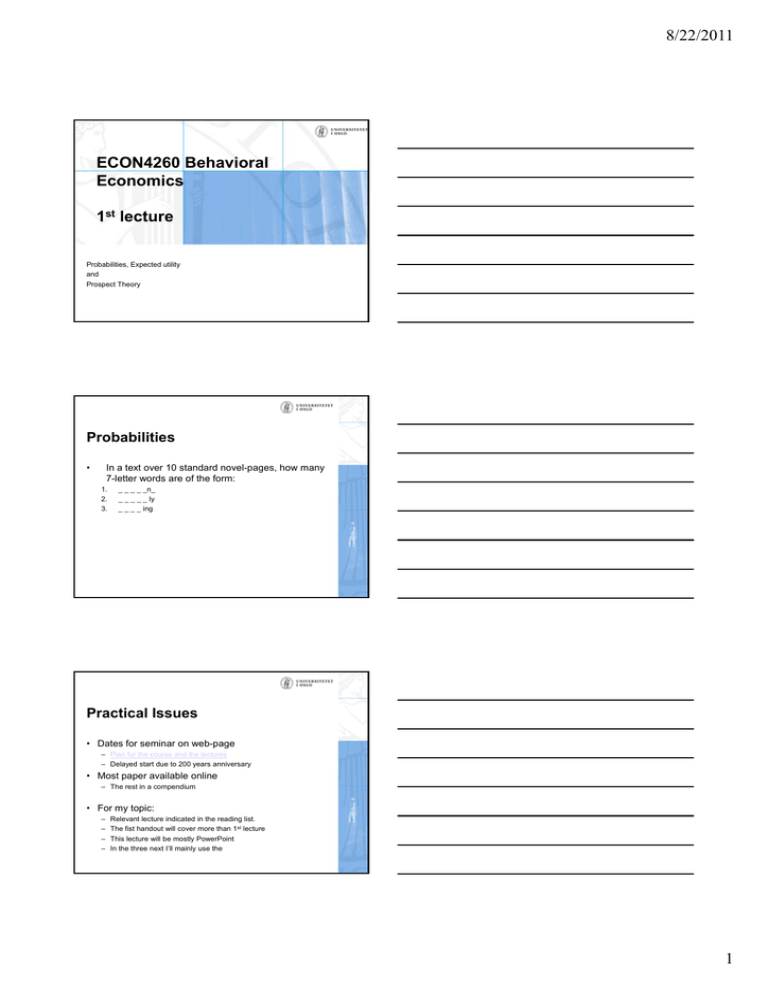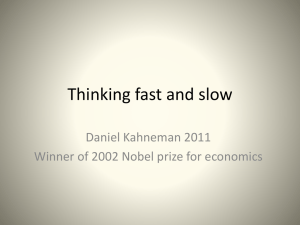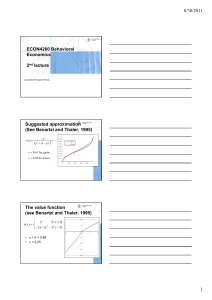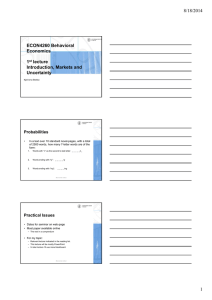8/22/2011 ECON4260 Behavioral Economics 1
advertisement

8/22/2011 ECON4260 Behavioral Economics 1st lecture Probabilities, Expected utility and Prospect Theory Probabilities • In a text over 10 standard novel-pages, how many 7-letter words are of the form: 1. 2. 3. _ _ _ _ _n_ _ _ _ _ _ ly _ _ _ _ ing Practical Issues • Dates for seminar on web-page – Plan for the course and the lectures – Delayed start due to 200 years anniversary • Most paper available online – The rest in a compendium • For my topic: – – – – Relevant lecture indicated in the reading list. The fist handout will cover more than 1st lecture This lecture will be mostly PowerPoint In the three next I’ll mainly use the 1 8/22/2011 Three main topics • Decision theory (Lectures 1-4) • Time preferences (Lectures 5-8) – 10$ today versus 11$ tomorrow – 10$ ten days from versus 11$ after 11 days • Justice / Non-selfish behavior (L 9-13) – Share 100 kroner with a recipient/responder – Dictators share – Responders reject unfair offers Time preferences / Self control • It is a good idea to read the papers before the lectures, and to allocate work evenly over the semester – Most students know – Some lack the self control to do it. • But then: – Who is the ’self’ if not the student? – If it is the student, who is the ’self’ controlling? • Theories of multiple selves • Enjoyable read (not curriculum): Robert Kurzban (2011) ”Why everyone (else) is a hypocrite” Princeton UP Study pre-commitment technique • Suppose at the start of the semester you decide to – Solve all seminar exercises in advance – Read all relevant papers on the reading list before each lecture – Attend all lectures and seminars • But you know that you (maybe) will not follow through – And that you will regret as exams are approaching • Make a contract with another student – Attend at least 90% of lectures and seminars – have someone to sign. – Have written answers to 80% of all seminar problem (signed) – If the contract is not met – give 5000 kroner to an organization that you disagree strongly with. (FrP? SV? ) • Homo oeconomicus would not need this contract – Why do we need it? Institutt for statsvitenskap 2 8/22/2011 Social preferences • When you watch someone in pain and when you yourself is in pain, some of the same neurons light up in your brain. • Old wisdom: We share others pain, sorrow, happiness. – But may enjoy their pain if they have done us wrong • Is it then reasonable to assume my utility only depend on my own consumption? • Enjoyable read (no curriculum): Franz de Waal (2009) ”The age of empathy.” Three river press – Morality evolved from the ability to mimic. The economic problem • What is important when we want to understand the economy? • Example of social preferences: – My utility depend on my income and yours (Fehr and Smith) – Reflect the mirror neurons? – But yields an even more complex optimization • What is the ideal model? – The simplest possible structure that fits data (Gul and Pesendorfer) – Representing what we know about the brain (Camerer m.fl.) – Representing the decision making process (Gigerenzer) References • Berg, Nathan and Gigerenzer, Gerd (2010). As-If Behavioral Economics: Neoclassical Economics in Disguise? History of Economic Ideas, Vol. 18, No. 1, pp. 133-166, 2010. Available at SSRN: http://ssrn.com/abstract 1677168 http://ssrn.com/abstract=1677168 • Camerer, Colin F., George Loewenstein and Drazen Prelec (2004) Neuroeconomics: Why Economics Needs Brains, Scandinavian Journal of Economics, Vol 105, pp 555-579. • Gul, Farok and Wolfgang Pesendorfer (2005): The Case for Mindless Economics, Princeton Institutt for statsvitenskap 3 8/22/2011 Gerd Gigerenzer: Fetching a ball • What is the best strategy to fetch a ball in the air (e.g. baseball) • Optimize – Estimate where it will land, run as fast as possible, update estimate with new information • Use a rule of thumb – Run to keep the ball at a constant angle. • Gigerenzer: We use the rule of thumb, and optimization is in fact an inferior strategy. Back to decision theory How to make the optimal decision in theory • For each alternative action: – Make an assessment of the probability distribution of outcomes – Compute the expected utility associated with each such probability distribution – Choose the action that maximize expected utility • How do people make probability assessment? Fundamental law of statistics • If the event A is contained in B then Pr(A) ≤ Pr(B) • Example: An urn contains Red, Red Blue and Green balls. A ball is drawn at random Pr(Red OR Blue) ≥ Pr(Red) • Conjunctions: A&B is contained in B Pr(A&B) ≤ Pr(B) • Applies to all alternatives to probability, like Belief functions and non-additive measures 4 8/22/2011 Linda • “Linda is 31 years old, single, outspoken and very bright. She majored in philosophy. As a student, she was deeply concerned with issues of discrimination and social justice, and also participated in anti-nuclear demonstrations.” – – – – – Linda is a teacher in elementary school Linda is active in the feminist movement (F) Linda is a bank teller (T) Linda is an insurance sales person Linda is a bank teller and is active in the feminist movement (T&F) • Probability rank (1=most probable): – Naïve: T&F : 3,3; T : 4,4 – Sophisticated: T&F : 3,2; T : 4,3. • Conjunction rule implies – Rank T&F should be lower than T (Less probable) Bill • Bill is 34 years old. He is intelligent but unimaginative, compulsive, and generally lifeless. In school he was strong in mathematics but weak in social studies and humanities. – – – – – – – – Bill is a p physician y who p play yp poker for a hobby y Bill is an architect Bill is an accountant (A) Bill plays jazz for a hobby (J) [Rank 4.5] Bill surfs for a hobby Bill is a reporter Bill is an accountant who play jazz for a hobby (A & J) [Rank 2.5] Bill climbs mountains for a hobby. Indirect and Direct tests • Indirect versus direct – Are both A&B and A in same questionnaire? – Paper show that direct and indirect tests yield roughly the same result. • Transparent (“increasingly ( increasingly desperate”) desperate ) – Argument 1: Linda is more likely to be a bank teller than she is to be a feminist bank teller, because every feminist bank teller is a bank teller, but some bank tellers are not feminists and Linda could be one of them (35%) – Argument 2: Linda is more likely to be a feminist bank teller than she is likely to be a bank teller, because she resembles an active feminist more than she resembles a bank teller (65%) 5 8/22/2011 Sophistication • Graduate student social sciences at UCB and Stanford • Credit for several statistics courses – ”Only 36% committed the fallacy” – Likelihood rank T&F (3.5) < T (3.8) ”for the first time?” • But: – Report sophisticated in Table 1.1, no effect As a lottery • ”If you could win $10 by betting on an event, which of the following would you choose to bet on? (check one)” – ”Only” 56 % choose T&F over F Extensional versus intuitive • Extensional reasoning – Lists, inclusions, exclusions. Events – Formal statistics. • If A B , Pr(A) ≥ Pr (B) • Moreover: ( A & B) B • Intuitive reasoning – Not extensional – Heuristic • Availability • Representativity. 6 8/22/2011 Representative versus probable • ”It is more representative for a Hollywood actress to be divorced 4 times than to vote Democratic.” (65%) • But • ”Among Hollywood actresses there are more women who vote Democratic than women who are divorced 4 times.” (83%) Representative heuristic • While people know the difference between representative and probable they are often correlated • More probable that a Hollywood actress is divorced 4 times than a the probability that an average woman is divorced 4 times. • Thus representativity works as a heuristic for probability. Availability Heuristics • We assess the probability of an event by the ease with witch we can create a mental picture of it. – • Works good most of the time. Frequency of words – – – – A: _ _ _ _ ing (13.4%) B: _ _ _ _ _ n _ ( 4.7%) Now, and hence Pr(B)≥Pr(A) But ….ing words are easier to imagine 7 8/22/2011 Predicting Wimbledon. • Provided Bjørn Borg makes it to the final: – He had won 5 times in a row, and was perceived as very strong. • What is the probability that he will (1 (1=most most probable) – Lose the first set (2.7) – Lose the first set but win the match (2.2) • It was easier to make a mental image of Bjørn Borg winning at Wimbledon, than losing. We like small samples to be representative • • • Dice with 4 green (G) and two red (R) faces Rolled 20 times, and sequence recorded B t on a sequence, and Bet d win i $25 if it appear 1. RGRRR 2. GRGRRR 3. GRRRRR • 33% 65% 2% Now most subject avoid the fallacy with the transparent design For the seminar A dice has four Green (G) faces and two Red (R) faces. The dice will be rolled 20 times, and the result (R or G) will be written down. This will produce a sequence of 20 letters. You can choose one of the three short sequences below: 1. RGRRR 2. GRGRRR 3 GRRRRR, 3. GRRRRR Suppose that if your chosen sequence appears in the sequence of 20 letters, you would win 500 kroner. Which one of the sequences 1.-3. would you prefer? “ • • • Ask 4 students each, two sophisticated and two non-sophisticated. You may collaborate and attend lectures for first year students and students at intermediate/advanced courses in statistics at the math department. Send me the results prior to 3rd lecture. Økonomisk Institutt 8 8/22/2011 More varieties • Doctors commit the conjunction fallacy in medical judgments • Adding reasons – NN h had dah heartt attack tt k – NN had a heart attack and is more than 55 years old • Watching TV affect our probability assessment of violent crimes, divorce and heroic doctors. (O’Guinn and Schrum) The critique from Gigerenser et.al • The Linda-case provide lots of irrelevant information • The word ’probability’ has many meanings – Only some corresponds to the meaning in mathematical statistics. • We are good at estimating probabilities – But only in concrete numbers – Not in abstract contingent probabilities. Given a positive HIV-test • Suppose HIV-test has the following quality – Non-infected have 99.9% probability of negative – Infected always test positive – 1 out of 1000 who are tested, are infected. • If y you did a HIV-test and g got a p positive. What is the probability that you are in fact infected? – Write down your answer. 9 8/22/2011 Suppose we test 1001 persons • Statistically 1 will be infected and test positive • Of the 1000 remaining, 99,9% will test negative, and one will test positive. (on average) • If you did a HIV-test and got a positive. What is the probability that you are in fact infected? – Write down your answer. An advise • If you want to learn statistical theory, especially understand contingent probabilities and Bayesian updating: – Translate into concrete numbers • This will enhance – Your understanding when you study it, and – Your ability retain what you have learned 10 years from now. Expected utility • Preferences over lotteries • Notation – (x1,p1;…;xn,pn)= x1 with probability p1; … and xn with probability pn – Null outcomes not listed: • (x1,p1) means x1 with probability p1 and 0 with probability 1-p1 – (x) means x with certainty. 10 8/22/2011 Independence Axiom • If A ~ B, then (A,p;L,1-p) ~ (B,p; L,1-p) • Add continuity: if b(est) > x > w(orst) then there is a p(=u(x)) p( u(x)) such that (b,p;w,1-p) ~ (x) • It follows that lotteries should be ranked according to Expected utility Max ∑ piu(xi) Proof • Start with any lottery (x1,p1;x2,p2 ) • Now, by continuity: – x1~ (b,u(x1);w,1-u(x1)) – x2~ (b,u(x2);w,1-u(x2)) • Replace x1 and x2 by the equally good lotteries (IA) • note that b and w are the only possible outcomes, – Probability of outcome: Pr(b) = p1u(x1)+p2u(x2) – (x1,p1;x2,p2 ) ~ (b,p1u(x1)+p2u(x2); w,1-p1u(x1)+p2u(x2)) • Note that Pr(b)=Eu(x) • Maximizing Eu = max probability of winning b. Positive linear transforms • Note that if v(x)=au(x)+b, a>0 • Then Ev= ∑ piv(xi) = ∑ piau(xi)+∑ pib =a Eu + b • Maximizing Ev equivalent to maximizing Eu • Useful in the following – Can choose u(0)=0 – Use v(x)=u(x)+b, with b=-u(0) 11 8/22/2011 Prospect theory • Loss and gains – Value v(x-r) rather than utility u(x) where r is a reference point. • Decisions weights replace probabilities Max ∑ iv(xi-r) ( Replaces Max ∑ piu(xi) ) Evidence; Decision weights • Problem 3 – A: (4 000, 0.80) – N=95 [20] or B: (3 000) [80]* or D: (3 000, 0.25) [35] • Problem 4 – C: (4 000, 0.20) – N=95 [65]* • Violates expected utility – B better than A : u(3000) > 0.8 u(4000) – C better than D: 0.25u(3000) > 0.20 u(4000) • Perception is relative: – 100% is more different from 95% than 25% is from 20% Value function Reflection effect • Problem 3 – A: (4 000, 0.80) – N=95 [20] or B: (3 000) [80] [80]* • Problem 3’ – A: (-4 000, 0.80) – N=95 [92]* or B: (-3 000) [8] • Ranking reverses with different sign (Table 1) • Concave (risk aversion) for gains and • Convex (risk lover) for losses 12 8/22/2011 The reference point • Problem 11: In addition to whatever you own, you have been given 1 000. You are now asked to choose between: – A: (1 000, 000 0 0.50) 50) – N=95 [16] or B: (500) [84]* • Problem 12: In addition to whatever you own, you have been given 2 000. You are now asked to choose between: – A: (-1 000, 0.50) – N=95 [69]* or B: (-500) [31] • Both equivalent according to EU, but the initial instruction affect the reference point. Decision weights • Suggested by Allais (1953). • Originally a function of probability i = f(pi) • This formulation violates stochastic dominance and are difficult to generalize to lotteries with many outcomes (pi→0) • The standard is thus to use cumulative prospect theory Lotto (Think about this until next week) • 50% of the money that people spend on Lotto is paid out as winning prices • Stylized: y – Spend 10 Kroner – Win 1 million kroner with probability 1 to 200 000 • Would a risk avers expected utility maximizer play Lotto? – Is Lotto participation a challenge to expected utility? • Can prospect theory explain why people participate in Lotto? 13 8/22/2011 Rank dependent weights • Order the outcome such that x1>x2>…>xk>0>xk+1>…>xn • Decision weights for gains j j 1 i 1 j w pi w pi for all j k i 1 • Decision weights for losses n i j 1 n j w pi w pi for all j k i j Cumulative prospect theory • Value-function – Concave for gains – Convex for losses – Kink at 0 • Decision weights – Adjust cumulative distribution from above and below • Maximize n v( x ) i 1 i i Main difference between CPT and EU • Loss aversion – Marginal utility twice as large for losses compared to gains • Certainty effects – 100% is distinctively different from 99% – 49% is about the same as 50% • Reflection – Risk seeking for losses – Risk aversion form gains. – Most risk avers when both losses and gains. 14







